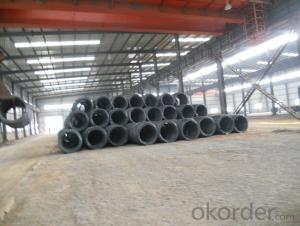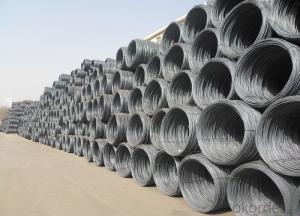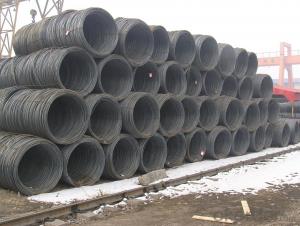Hot Rolled Prime Steel Wire Rod in Coils
- Loading Port:
- China main port
- Payment Terms:
- TT OR LC
- Min Order Qty:
- 100 m.t.
- Supply Capability:
- 10000 m.t./month
OKorder Service Pledge
OKorder Financial Service
You Might Also Like
Item specifice
Product Description:
OKorder is offering Prime Hot Rolled Steel Wire Rod in Coils at great prices with worldwide shipping. Our supplier is a world-class manufacturer of steel, with our products utilized the world over. OKorder annually supplies products to African, South American and Asian markets. We provide quotations within 24 hours of receiving an inquiry and guarantee competitive prices.
Product Applications:
Prime Hot Rolled Steel Wire Rod in Coils are ideal for structural applications and are widely used in construction and manufacturing. Carbon steel wire rod is mainly used for reinforcement of reinforced concrete and welded structure or reprocessed (roberts , nail, etc.) materials, especially used to produce wire drawing, welding electrode, nails, spring, electronic, precise machinery parts and so on.
Product Advantages:
OKorder's Prime Hot Rolled Steel Wire Rod in Coils are durable, strong, and wide variety of sizes.
Main Product Features:
· Premium quality
· Prompt delivery & seaworthy packing (30 days after receiving deposit)
· Can be recycled and reused
· Mill test certification
· Professional Service
· Competitive pricing
Product Specifications:
Manufacture: Hot rolled
Grade: HRB400,HRB400E,HRB500
Certificates: ISO, SGS, BV, CIQ
Packaging: Export packing, nude packing, in coils, each coil around 2mt
Size: 5.5mm, 6.5mm, 8mm, 10mm
Grade | Chemical Composition(%) | |||||
C | Mn | Si | S | P | B | |
SAE1006B | 0.03~O.07 | ≤0.32 | ≤0.30 | ≤0.045 | ≤0.040 | >0.0008 |
Mechanical properties | ||||||
Yield strength(N/mm2) | Tensile strength(N/mm2) | Elongation(%) | ||||
250-280 | 350-380 | ≥32 | ||||
Grade | Chemical Composition(%) | |||||
C | Mn | Si | S | P | B | |
SAE1008B | 0.10max | 0.3~O.50 | 0.15max | 0.050max | 0.040 max | 0.0008 min |
Mechanical properties | ||||||
Yield strength(N/mm2) | Tensile strength(N/mm2) | Elongation(%) | ||||
FAQ:
Q1: Why buy Materials & Equipment from OKorder.com?
A1: All products offered byOKorder.com are carefully selected from China's most reliable manufacturing enterprises. Through its ISO certifications, OKorder.com adheres to the highest standards and a commitment to supply chain safety and customer satisfaction.
Q2: How do we guarantee the quality of our products?
A2: We have established an advanced quality management system which conducts strict quality tests at every step, from raw materials to the final product. At the same time, we provide extensive follow-up service assurances as required.
Q3: How soon can we receive the product after purchase?
A3: Within three days of placing an order, we will arrange production. The normal sizes with the normal grade can be produced within one month. The specific shipping date is dependent upon international and government factors, the delivery to international main port about 45-60days.
Images:
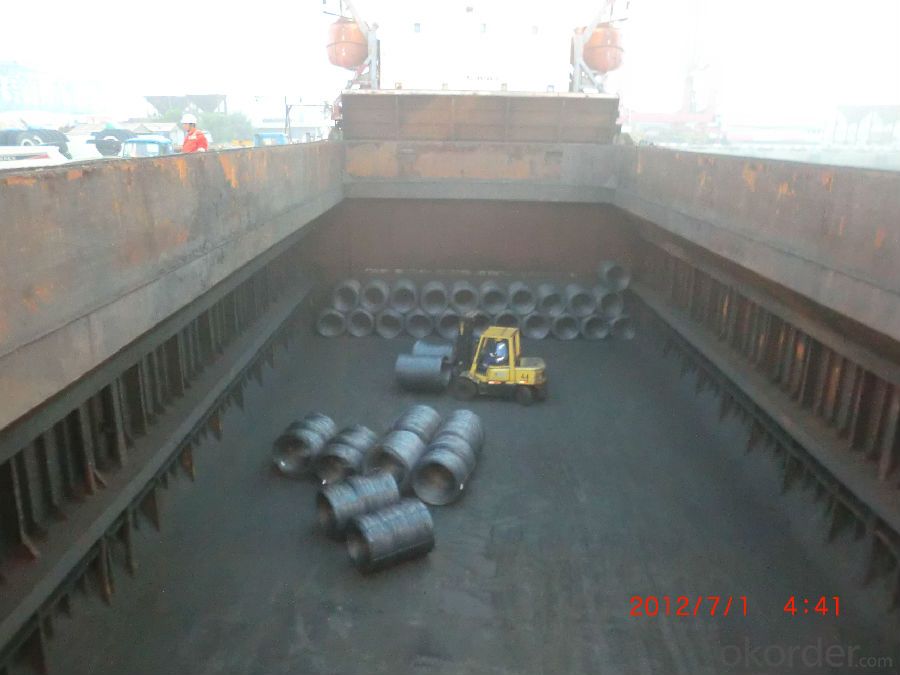

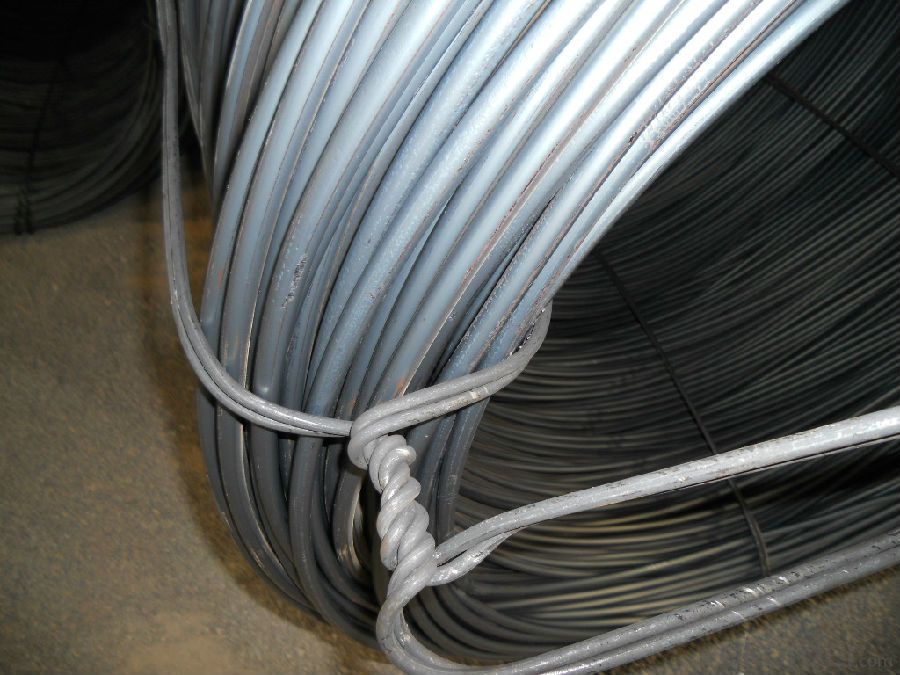
- Q:What are the major applications of high carbon steel wire rod?
- Some major applications of high carbon steel wire rod include construction materials such as wire mesh, nails, and screws, as well as automotive components like springs and suspension systems. It is also used in the manufacturing of industrial machinery, electrical equipment, and various types of wire products.
- Q:How is steel wire rod used in the production of wire grids?
- Steel wire rod is used in the production of wire grids by being drawn and stretched to the desired thickness and shape. This wire rod serves as the raw material that is woven or welded together to form the wire grids, which are commonly used in various applications such as fencing, shelving, and industrial racks.
- Q:How is steel wire rod used in the manufacturing of electrical wires?
- Steel wire rod is used in the manufacturing of electrical wires as it serves as the base material for the wire's core. The steel wire rod is first drawn into a desired diameter, coated with an insulating material, and then further processed to create the final electrical wire. This allows for the wire to have high conductivity, strength, and durability, making it suitable for conducting electricity safely and efficiently.
- Q:What are the common industry certifications for steel wire rod?
- The common industry certifications for steel wire rod include ISO 9001:2015, ASTM A510/A510M, and EN 10025-2:2004.
- Q:How is the fatigue strength of steel wire rod determined?
- The fatigue strength of steel wire rod is determined through a series of tests that involve subjecting the material to repeated loading and unloading cycles until failure occurs. This process, known as fatigue testing, helps to determine the endurance limit or fatigue strength of the wire rod. During the fatigue testing process, a sample of the steel wire rod is prepared according to specific standards and guidelines. The sample is typically in the form of a specimen with a standardized shape and dimensions. The preparation of the sample involves carefully machining the wire rod to remove any surface imperfections or irregularities that could affect the test results. The next step is to subject the sample to cyclic loading, where a varying load is applied to the wire rod repeatedly. This can be done using specialized testing machines that apply the load in a controlled manner. The load applied during the testing process can be either constant amplitude or variable amplitude, depending on the specific requirements of the test. The sample is typically loaded with a range of stress amplitudes, starting from a relatively low value and gradually increasing until failure occurs. The number of cycles to failure is recorded for each stress level, and this data is used to create an S-N curve, also known as a fatigue curve. The S-N curve represents the relationship between the applied stress amplitude and the number of cycles to failure. By analyzing the S-N curve, engineers can determine the fatigue strength of the steel wire rod. The fatigue strength is generally defined as the stress amplitude at which the material can withstand an infinite number of cycles without failure. This is commonly referred to as the endurance limit. In addition to fatigue testing, other factors can also influence the fatigue strength of steel wire rod, including material composition, surface finish, and environmental conditions. Therefore, it is important to consider these factors when determining the fatigue strength of the wire rod for specific applications.
- Q:What are the different types of steel wire rod coatings used for improved ductility?
- There are several different types of steel wire rod coatings that are used to enhance ductility. These coatings are applied to the surface of the wire rod to provide a protective layer and improve its mechanical properties. Some of the commonly used coatings include: 1. Zinc Coating: This is one of the most widely used coatings for steel wire rods. Zinc coatings provide excellent corrosion resistance and enhance ductility by reducing the formation of brittle intermetallic compounds. The most common zinc coating method is hot-dip galvanizing, where the wire rod is immersed in a bath of molten zinc. 2. Copper Coating: Copper coatings are often used in conjunction with zinc coatings to provide additional protection against corrosion. Copper enhances ductility by reducing the formation of brittle phases and improving the wire rod's resistance to cracking during deformation. 3. Phosphate Coating: Phosphate coatings are applied to steel wire rods to improve lubricity and reduce friction during drawing and forming processes. These coatings also enhance adhesion between the wire rod and subsequent coatings, such as zinc or copper. 4. Polymer Coating: Polymer coatings, such as epoxy or polyvinyl chloride (PVC), are used to provide a protective layer against corrosion and improve ductility. These coatings act as a barrier between the wire rod and the environment, preventing the penetration of moisture and corrosive substances. 5. Chromium Coating: Chromium coatings are often used in high-strength steel wire rods to improve ductility and reduce the risk of hydrogen embrittlement. These coatings enhance the wire rod's resistance to cracking and enhance its mechanical properties. It is important to note that the choice of coating depends on the specific application and desired properties of the steel wire rod. Different coatings offer varying levels of corrosion resistance, lubricity, and adhesion, which can be tailored to meet the requirements of different industries and applications.
- Q:How is steel wire rod used in the manufacturing of wire cables?
- Steel wire rod is used as a raw material in the manufacturing of wire cables. It is first drawn through a series of dies to reduce its diameter and increase its strength. The resulting wire is then twisted or braided together to form cables of various sizes and configurations. The steel wire rod provides the necessary strength and durability to withstand the tension and stress that wire cables typically encounter in their applications.
- Q:What is the difference between a wire rod and a straight bar?
- Straight line refers to the production, delivery is a bundle of straight material delivery in winter, used for the diameter of coarse steel bar, general specifications of 9 meters and 12 meters, the dosage is large (1000 tons or more), steel mills will consider the order made
- Q:What are the common warranty considerations for steel wire rod?
- There are several common warranty considerations for steel wire rod, including the durability and strength of the material, compliance with industry standards and specifications, and the absence of defects such as surface imperfections or dimensional inaccuracies. Additionally, warranties often cover the performance of the wire rod in specific applications, such as its ability to withstand corrosion or maintain its structural integrity over time.
- Q:What are the specifications for steel wire rod used in offshore wire strands?
- The specifications for steel wire rod used in offshore wire strands are typically determined by industry standards and regulations. These specifications are designed to ensure the safety and reliability of the wire strands used in offshore applications. Some of the key specifications for steel wire rod used in offshore wire strands include: 1. Material composition: The steel wire rod used in offshore wire strands should be made from high-quality carbon steel or alloy steel. The material composition should meet specific requirements in terms of strength, durability, and corrosion resistance. 2. Tensile strength: The wire rod should have a high tensile strength to withstand the heavy loads and stresses experienced in offshore environments. The required tensile strength may vary depending on the specific application and project requirements. 3. Diameter and tolerance: The wire rod should have a specific diameter and tolerance to ensure compatibility with the wire strand manufacturing process. The diameter and tolerance may vary depending on the wire strand design and application. 4. Surface finish: The wire rod should have a smooth surface finish to facilitate proper adhesion and bonding with the surrounding materials, such as resin or protective coatings. The surface finish should also be free from any defects, such as cracks or scratches, which could compromise the performance of the wire strand. 5. Corrosion resistance: Offshore environments are exposed to harsh conditions, including saltwater, moisture, and corrosive elements. Therefore, the steel wire rod used in offshore wire strands should have excellent corrosion resistance properties to prevent degradation and maintain structural integrity over time. 6. Certified testing and quality control: The wire rod should undergo rigorous testing and quality control measures to ensure compliance with industry standards and specifications. This may include testing for mechanical properties, chemical composition, surface finish, and corrosion resistance. It is important to note that the specific specifications for steel wire rod used in offshore wire strands may vary depending on the project requirements, industry standards, and local regulations. Therefore, it is essential to consult the relevant codes and standards applicable to the specific offshore application to determine the exact specifications for the wire rod.
1. Manufacturer Overview |
|
|---|---|
| Location | |
| Year Established | |
| Annual Output Value | |
| Main Markets | |
| Company Certifications | |
2. Manufacturer Certificates |
|
|---|---|
| a) Certification Name | |
| Range | |
| Reference | |
| Validity Period | |
3. Manufacturer Capability |
|
|---|---|
| a)Trade Capacity | |
| Nearest Port | |
| Export Percentage | |
| No.of Employees in Trade Department | |
| Language Spoken: | |
| b)Factory Information | |
| Factory Size: | |
| No. of Production Lines | |
| Contract Manufacturing | |
| Product Price Range | |
Send your message to us
Hot Rolled Prime Steel Wire Rod in Coils
- Loading Port:
- China main port
- Payment Terms:
- TT OR LC
- Min Order Qty:
- 100 m.t.
- Supply Capability:
- 10000 m.t./month
OKorder Service Pledge
OKorder Financial Service
Similar products
New products
Hot products
Hot Searches
Related keywords
